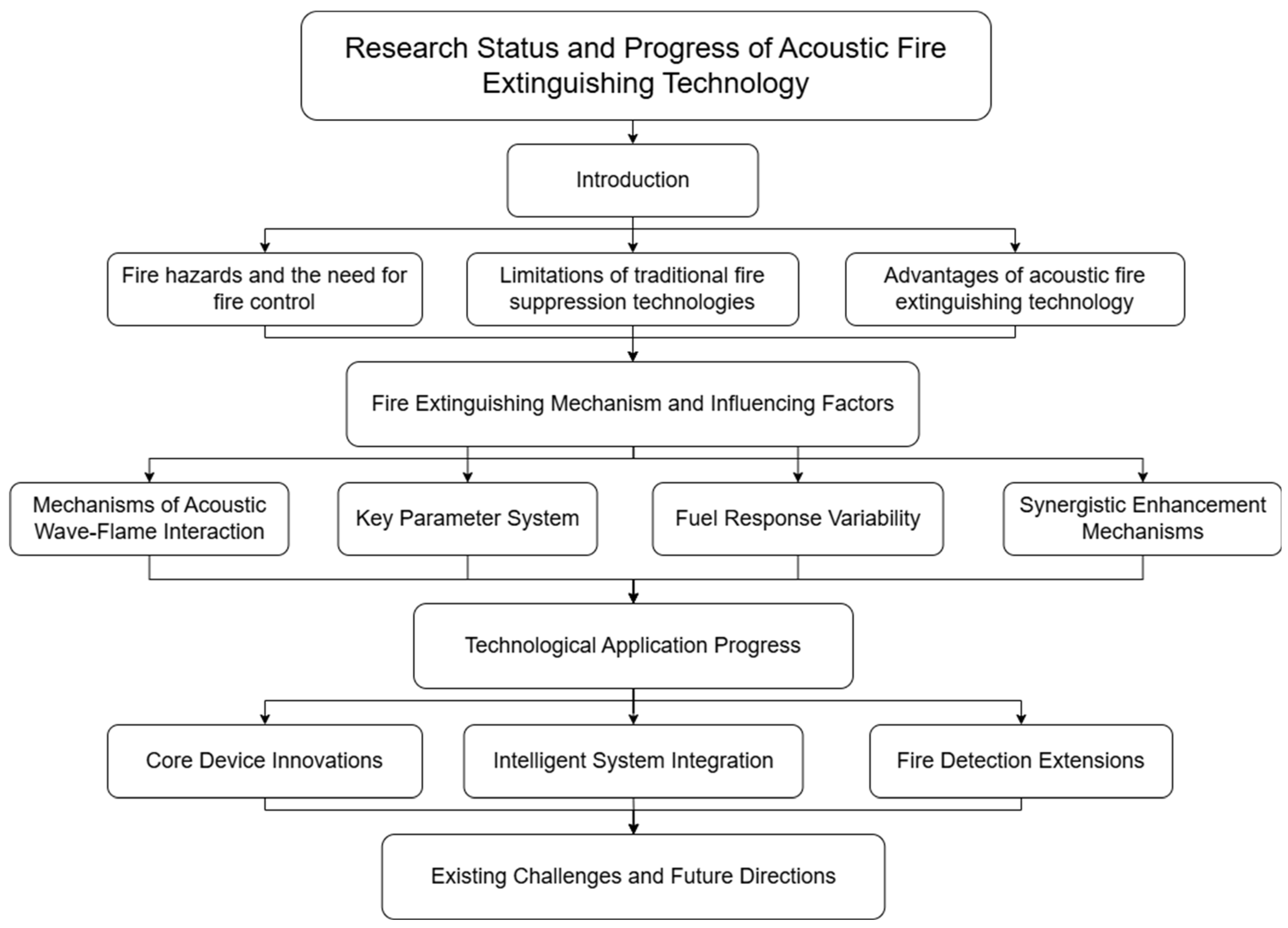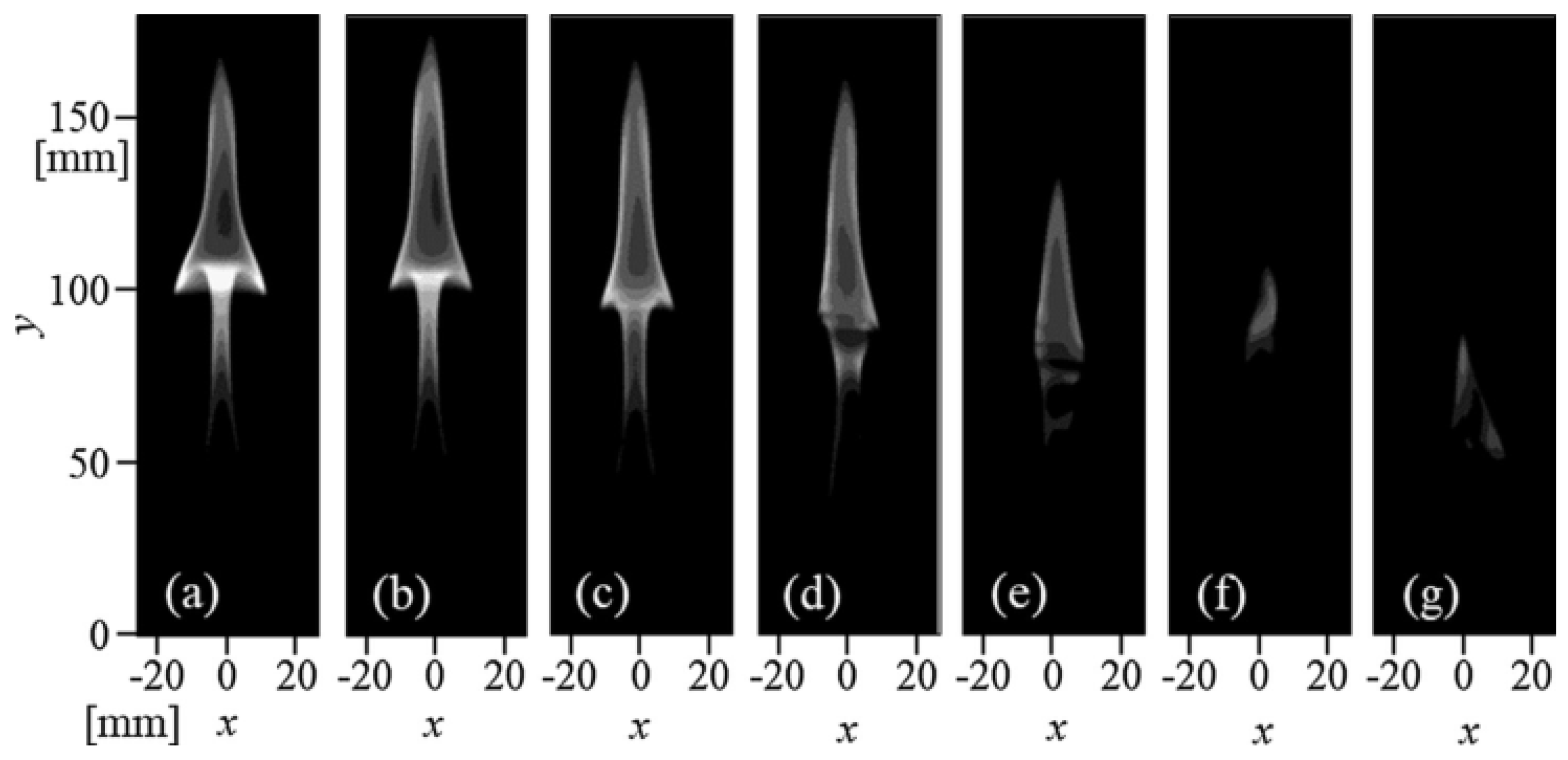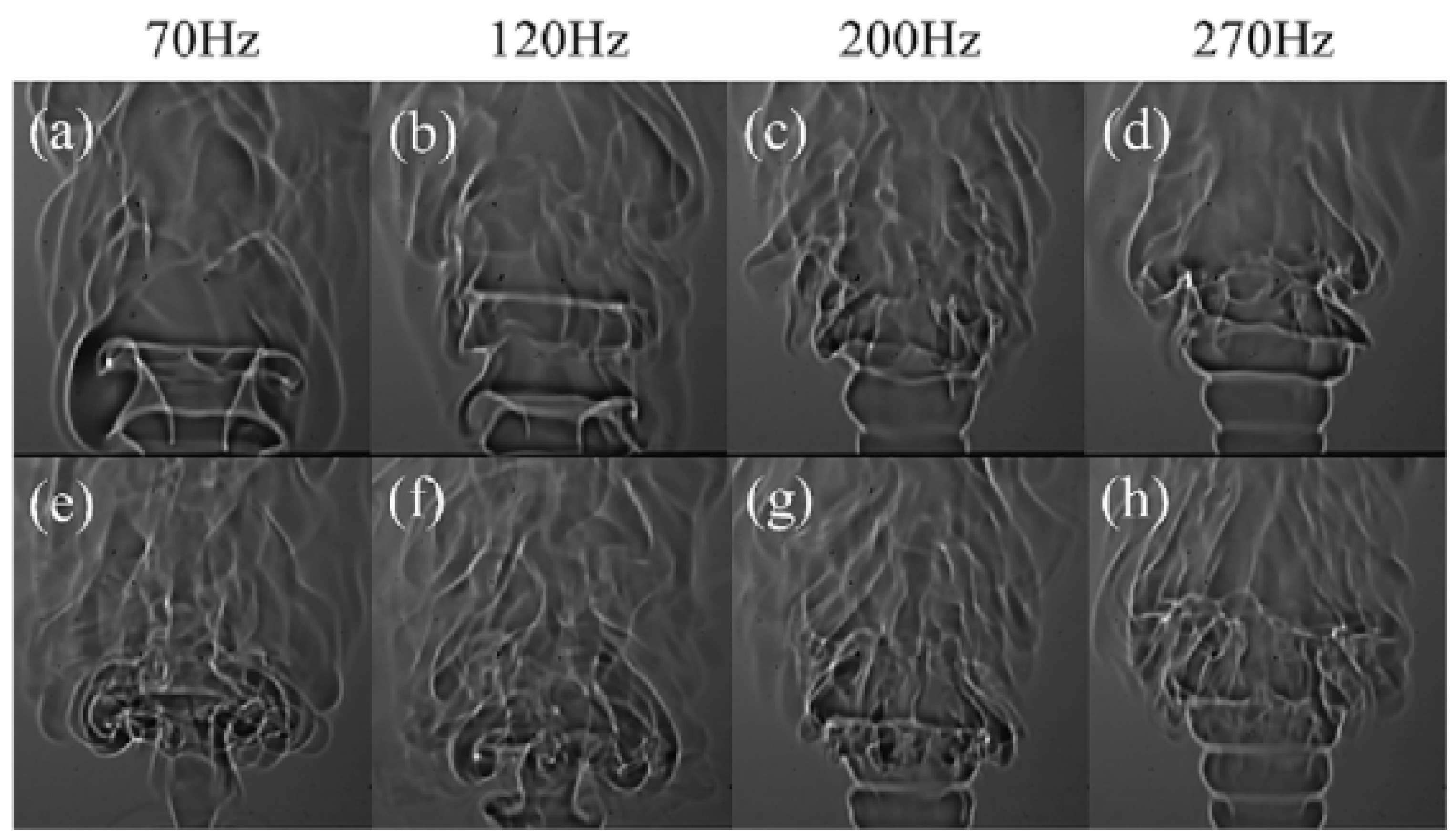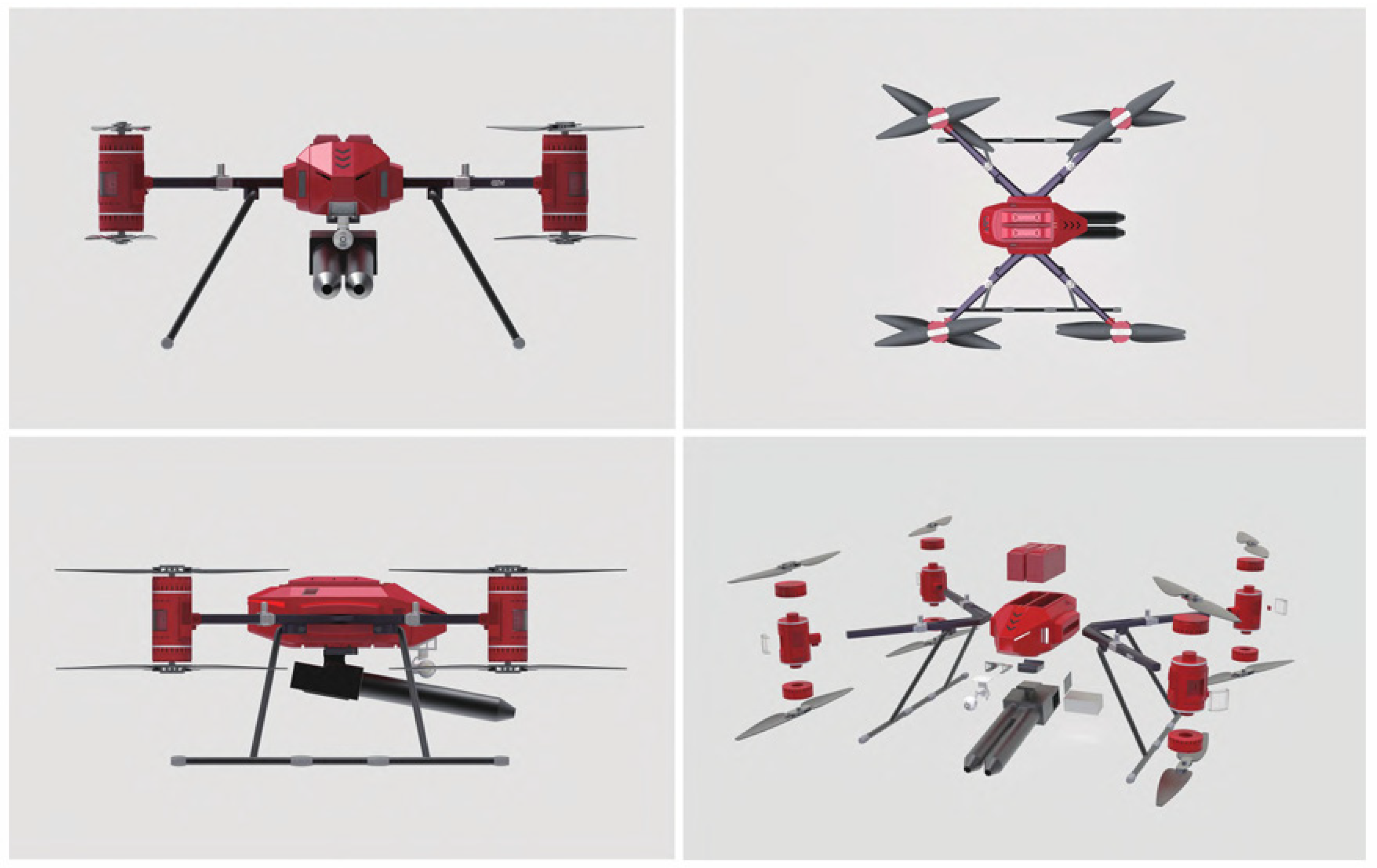Research Status and Progress of Acoustic Fire Extinguishing Technology
Abstract
1. Introduction
2. Fire Extinguishing Mechanism and Influencing Factors
2.1. Influence Mechanism of Acoustic Waves on Flame Behavior
2.2. Key Parameters of Acoustic Fire Extinction
2.3. Response Characteristics of Flames from Different Fuels to Acoustic Waves
2.4. Synergistic Enhancement Mechanism of Sound Waves and Water Mist
3. Application of Acoustic Fire Extinguishing Technology
4. Challenges and Future Research Directions
4.1. In-Depth Study of Acoustic Fire Suppression Mechanisms
4.2. Optimization of Acoustic Parameters and Control Strategies
4.3. Applicability of Acoustic Fire Suppression in Microgravity and Extreme Environments
4.4. Engineering Applications of Acoustic Fire Suppression
4.5. Intelligent Control of Acoustic Fire Suppression
5. Conclusions
- Variations in acoustic parameters (such as frequency and sound pressure level) and experimental conditions across different studies limit the cross-comparability and generalizability of the results.
- Existing research primarily focuses on liquid and gaseous fuels, with relatively few studies on solid fuels and complex environments (such as microgravity and high-temperature turbulence), which may affect the comprehensiveness and applicability of the conclusions.
- Since technological advancements in the industrial sector are not fully disclosed, the effectiveness of practical engineering applications requires further validation.
Author Contributions
Funding
Institutional Review Board Statement
Informed Consent Statement
Data Availability Statement
Conflicts of Interest
References
- Zheng, J.; Zhang, L.; Gong, J. Feature analysis and comparison of prediction methods for fire accidents. Int. J. Saf. Secur. Eng. 2020, 10, 707–712. [Google Scholar] [CrossRef]
- Daoud, Z.; Ben Hamida, A.; Ben Amar, C. A one stream three-dimensional convolutional neural network for fire recognition based on Spatio-temporal fire analysis. Evol. Syst. 2024, 15, 2355–2381. [Google Scholar] [CrossRef]
- Ying, L.; Wen, R. Analysis of subway fire accident based on Bayesian network. J. Phys. Conf. Ser. 2021, 1910, 012039. [Google Scholar]
- Qin, R.; Shi, C.; Yu, T. Analysis of factors influencing fire accidents in commercial complexes based on WSR-DEMATEL-ISM model. Fire 2024, 7, 224. [Google Scholar] [CrossRef]
- Zhan, C.; Yu, F. Research on forest fire fescue path planning based on improved A* algorithm. Int. J. Front. Eng. Technol. 2022, 4, 1–5. [Google Scholar] [CrossRef]
- Franchini, A.; Galasso, C.; Torero, L.J. Probabilistic performance-based fire design of structures: A hazard-centred and consequence-oriented perspective. Fire Technol. 2024, 60, 2845–2873. [Google Scholar] [CrossRef]
- Zhang, Y. Research on Vulnerability of Fire Safety Management System Under the Background of Urbanization. Ph.D. Thesis, Chongqing University, Chongqing, China, 2021. (In Chinese). [Google Scholar]
- Zheng, L.; Min, Y.; Zhen, L. A chemical accident cause text mining method based on improved accident triangle. BMC Public Health 2024, 24, 39. [Google Scholar]
- Lin, X.; Song, S.; Zhai, H. Using catastrophe theory to analyze subway fire accidents. Int. J. Syst. Assur. Eng. Manag. 2020, 11, 223–235. [Google Scholar] [CrossRef]
- Zhang, Z.; Yang, Y.; Zhai, R. Study on influencing factors of thermal efficiency and exergy efficiency of oxygen-rich boiler. J. North China Electr. Power Univ. (Nat. Sci. Ed.) 2019, 46, 81–89. (In Chinese) [Google Scholar]
- Wang, Y.; Liu, Y.; Li, H. Numerical simulation on influencing factors of pulverized coal combustion in rotary kiln. Process Eng. 2023, 23, 1587–1598. (In Chinese) [Google Scholar]
- Thielsch, M.T.; Kirsch, J. Fight or flight? Behaviour and experiences of laypersons in the face of an incipient fire. Ergonomics 2021, 64, 149–170. [Google Scholar] [CrossRef] [PubMed]
- Duan, J. Research on Water-Based Fire Extinguishing Agent Based on Hydrocarbon and Silicone Surfactant Compounding System. Master’s Thesis, Nanjing University of Science & Technology, Nanjing, China, 2020. (In Chinese). [Google Scholar]
- Wang, Y. The Study of Thermal Decomposition and Fire Extinguishing Performance of the New Clean Extinguishant. Master’s Thesis, Hebei University of Technology, Tianjin, China, 2020. (In Chinese). [Google Scholar]
- Tang, Y.; Wu, R.; Fang, S. Application of Halon alternative extinguishing agent in confined space platform. Jiangsu Sci. Technol. Inf. 2020, 37, 55–57. (In Chinese) [Google Scholar]
- Xu, Z.; Guo, X.; Yan, L. Fire-extinguishing performance and mechanism of aqueous film-forming foam in diesel pool fire. Case Stud. Therm. Eng. 2020, 17, 100578. [Google Scholar] [CrossRef]
- Gonkowski, S.; Ochoa-Herrera, V. Poly- and perfluoroalkyl substances (PFASs) in amphibians and reptiles—Exposure and health effects. Aquat. Toxicol. 2024, 270, 106907. [Google Scholar] [CrossRef]
- Li, S.; Liu, L.; Zhuang, S. The influence of the change of key parameters of typical fire extinguisher on actual fire extinguishing performance. Fire Sci. Technol. 2022, 41, 1278–1281. (In Chinese) [Google Scholar]
- Chen, Y. Development Trend Prediction of Ship Fire Protection Technology Based on Patent Analysis. Master’s Thesis, Huazhong University of Science and Technology, Wuhan, China, 2022. (In Chinese). [Google Scholar]
- Wilk-Jakubowski, J.; Stawczyk, P.; Ivanov, S. High-power acoustic fire extinguisher with artificial intelligence platform. Int. J. Comput. Vis. Robot. 2022, 12, 236–249. [Google Scholar] [CrossRef]
- Tyndall, J. Sound (A Course of Eight Lectures Delivered at the Royal Institution of Great Britain). Lect. III 2014, 10, 86–124. [Google Scholar] [CrossRef][Green Version]
- Blaszczyk, J. Acoustically disturbed fuel droplet combustion. Fuel 1991, 70, 1023–1025. [Google Scholar] [CrossRef]
- Friedman, A.N.; Stoliarov, S.I. Acoustic extinction of laminar line-flames. Fire Saf. J. 2017, 93, 102–113. [Google Scholar] [CrossRef]
- Niegodajew, P.; Gruszka, K.; Gnatowska, R.; Šofer, M. Application of acoustic oscillations in flame extinction in a presence of obstacle. J. Phys. Conf. Ser. 2018, 1101, 012023. [Google Scholar] [CrossRef]
- Xiong, C.; Wang, Z.; Huang, X. Acoustic flame extinction by the sound wave or speaker-induced wind? Fire Saf. J. 2021, 126, 103479. [Google Scholar] [CrossRef]
- Xiong, C.; Liu, Y.; Xu, C. Response of buoyant diffusion flame to the low-frequency sound. J. Eng. Phys. 2022, 43, 553–558. (In Chinese) [Google Scholar]
- Yang, Y. Study on Fire Extinguishing Mechanism and Acoustic Cavity Optimization of Acoustic Fire Extinguishing Device. Master’s Thesis, Hunan University of Science and Technology, Xiangtan, China, 2023. (In Chinese). [Google Scholar]
- Cliftmann, J.M.; Anderson, B.E. Remotely extinguishing flames through transient acoustic streaming using time reversal focusing of sound. Sci. Rep. 2024, 14, 30049. [Google Scholar] [CrossRef] [PubMed]
- FACHINI, F.F. Transient effects in the droplet combustion process in an acoustically perturbed high temperature environment. Combust. Sci. Technol. 1996, 139, 173–189. [Google Scholar] [CrossRef]
- Zheng, L.; Ji, S.; Zhang, Y. Lifted and reattached behaviour of laminar premixed flame under external acoustic excitation. Exp. Therm. Fluid Sci. 2018, 98, 683–692. [Google Scholar] [CrossRef]
- Shi, X.; Zhang, Y.; Chen, X. The response of an ethanol pool fire to transverse acoustic waves. Fire Saf. J. 2021, 125, 103416. [Google Scholar] [CrossRef]
- Shi, X.; Zhang, Y.; Zhang, Y. Combustion characteristics of an ethanol pool fire perturbed by low-frequency acoustic waves. J. Eng. Phys. 2022, 43, 830–839. (In Chinese) [Google Scholar] [CrossRef]
- Yang, Y.; Jiang, G.; Liu, L. Research progress and prospects on the influence of sound waves on the combustion characteristics of coal powder. J. Coal 2023, 48, 3895–3911. (In Chinese) [Google Scholar]
- Zhang, Y.; Lin, G.; Zhang, Y. Simulation of combustion behavior of pool flame under transverse acoustic wave. Combust. Sci. Technol. 2023, 29, 381–389. (In Chinese) [Google Scholar]
- Hauser, M.; Lorenz, M.; Sattelmayer, T. Influence of transversal acoustic excitation of the burner approach flow on the flame structure. J. Eng. Gas Turbines Power 2011, 133. [Google Scholar] [CrossRef]
- Wang, Q.; Zhang, Y.; Tang, H.J.; Zhu, M. Visualization of diffusion flame/vortex structure and dynamics under acoustic excitation. Combust. Sci. Technol. 2012, 184, 1445–1455. [Google Scholar] [CrossRef]
- Wang, Y.; Zhu, M. Flame dynamics and their effect on thermoacoustic instabilities. J. Tsinghua Univ. (Nat. Sci. Ed.) 2022, 62, 785–793. (In Chinese) [Google Scholar]
- Wang, Z.; Pan, D.; Zhu, T. Dynamic modal analysis of diffusion flame under acoustic excitation. Therm. Sci. Technol. 2024, 23, 45–52. (In Chinese) [Google Scholar]
- FILHO, F.F. The effects of the acoustic field on droplet extinction processes. Combust. Sci. Technol. 1996, 120, 237–253. [Google Scholar] [CrossRef]
- Chen, L.; Wang, Q.; Zhang, Y. Flow characterisation of diffusion flame under non-resonant acoustic excitation. Exp. Therm. fluid Sci. 2013, 45, 227–233. [Google Scholar] [CrossRef]
- Wang, J.; Mei, X.; Wang, Q. Frequency response of a diffusion methane jet flame under transverse acoustic excitations. Chin. Sci. Pap. 2019, 14, 879–883. (In Chinese) [Google Scholar]
- Zhang, Y.; Lin, G.; Shi, X. Flame structure and oscillation characteristics of ethanol pool flame under transverse acoustic force. Chin. J. Eng. 2022, 44, 1453–1461. (In Chinese) [Google Scholar]
- McKinney, D.J.; Dunn-Rankin, D. Acoustically driven extinction in a droplet stream flame. Combust. Sci. Technol. 2000, 161, 27–48. [Google Scholar] [CrossRef]
- Zong, R.; Kang, R.; Liu, C.; Zhang, Z.; Zhi, Y. Analysis of flame extinguishment and height in low frequency acoustically excited methane jet diffusion flame. Microgravity Sci. Technol. 2018, 30, 237–242. [Google Scholar] [CrossRef]
- Niegodajew, P.; Łukasiak, K.; Radomiak, H.; Musiał, D.; Zajemska, M.; Poskart, A.; Gruszka, K. Application of acoustic oscillations in quenching of gas burner flame. Combust. Flame 2018, 194, 245–249. [Google Scholar] [CrossRef]
- Taspinar, Y.S.; Koklu, M.; Altin, M. Classification of flame extinction based on acoustic oscillations using artificial intelligence methods. Case Stud. Therm. Eng. 2021, 28, 101561. [Google Scholar] [CrossRef]
- Su, Z.; Qi, D.; Yu, R.; Yang, K.; Chen, M.; Zhao, X.; Zhang, G.; Ying, Y.; Liu, D. Response behavior of inverse diffusion flame to low frequency acoustic field. Combust. Sci. Technol. 2024, 1–29. [Google Scholar] [CrossRef]
- Wilk-Jakubowski, J.L. Experimental Study of the Influence of Even Harmonics on Flame Extinguishing by Low-Frequency Acoustic Waves with the Use of High-Power Extinguisher. Appl. Sci. 2024, 14, 11809. [Google Scholar] [CrossRef]
- Fujisawa, N.; Iwasaki, K.; Fujisawa, K. Flow visualization study of a diffusion flame under acoustic excitation. Fuel 2019, 251, 506–513. [Google Scholar] [CrossRef]
- Ou, Y. Research on Key Technology and Device of Sonic Fire Extinguishing. Master’s Thesis, Hunan University of Science and Technology, Xiangtan, China, 2022. (In Chinese). [Google Scholar]
- Tanabe, M.; Kuwahara, T.; Satoh, K.; Fujimori, T.; Sato, J.; Kono, M. Droplet combustion in standing sound waves. Proc. Combust. Inst. 2005, 30, 1957–1964. [Google Scholar] [CrossRef]
- Dattarajan, S.; Lutomirski, A.; Lobbia, R.; Smith, O.; Karagozian, A. Acoustic excitation of droplet combustion in microgravity and normal gravity. Combust. Flame 2006, 144, 299–317. [Google Scholar] [CrossRef]
- Suto, K.; Miyanabe, K.; Nishiyama, H.; Kato, N.; Ujikawa, H.; Suzuki, K.-I. QoE-guaranteed and power-efficient network operation for cloud radio access network with power over fiber. IEEE Trans. Comput. Soc. Syst. 2015, 2, 127–136. [Google Scholar] [CrossRef]
- Beisner, E.; Wiggins, N.D.; Yue, K.B.; Rosales, M.; Penny, J.; Lockridge, J.; Page, R.; Smith, A.; Guerrero, L. Acoustic flame suppression mechanics in a microgravity environment. Microgravity Sci. Technol. 2015, 27, 141–144. [Google Scholar] [CrossRef]
- Krikunova, A.I.; Cheshko, A.D. Complex gravity-acoustic impact on M-flame structure. Acta Astronaut. 2023, 204, 776–786. [Google Scholar] [CrossRef]
- Wen, Y.; Li, X.; Li, L. Design and ground testing of an acoustic slot burner for microgravity combustion experiments aboard the Chinese space station. J. Tsinghua Univ. (Sci. Technol.) 2025, 1–12. (In Chinese) [Google Scholar]
- Zhang, Y. Combustion and Flame Extinguishing Characteristics of Wood by Acoustic Waves Interference. Master’s Thesis, Xi’an University of Science and Technology, Xi’an, China, 2022. (In Chinese). [Google Scholar]
- Loboichenko, V.; Wilk-Jakubowski, G.; Wilk-Jakubowski, J.L.; Ciosmak, J. Application of Low-Frequency acoustic waves to extinguish flames on the basis of selected experimental attempts. Appl. Sci. 2024, 14, 8872. [Google Scholar] [CrossRef]
- Xiong, C.; Liu, Y.; Xu, C. Extinguishing the dripping flame by acoustic wave. Fire Saf. J. 2021, 120, 103109. [Google Scholar] [CrossRef]
- Shi, X.; Ren, X.; Zhang, Y. Dynamic characteristics and response mechanism of pool fire under external acoustic excitation. Therm. Sci. Eng. Prog. 2025, 103279. [Google Scholar] [CrossRef]
- Yu, X.; Zhao, X.; Ma, K. Dynamic response characteristics of premixed swirling tubular flame under acoustic disturbance. Aerodynamics 2020, 35, 1655–1663. (In Chinese) [Google Scholar]
- Wu, Y.; Fu, C.; Gao, Y. Experiment on nonlinear response of swirling bluff-body flame with external acoustic forcing. Aerodynamics 2022, 37, 1872–1885. (In Chinese) [Google Scholar]
- Wei, D.; Fang, H.; Hu, L. Effect of acoustic excitation on the combustion and emission characteristics of methane-ammonia-air swirling flame. Fuel 2023, 352, 129117. [Google Scholar] [CrossRef]
- Friedman, A.N.; Danis, P.I.; Fiola, G.J.; Barnes, C.A.; Stoliarov, S.I. Acoustically enhanced water mist suppression of heptane fueled flames. Fire Technol. 2018, 54, 1829–1840. [Google Scholar] [CrossRef]
- Huang, Y.; Wang, M.; Yang, K. Role of acoustic wave on extinguishing flames coupling with water mist. Case Stud. Therm. Eng. 2022, 38, 102367. [Google Scholar] [CrossRef]
- Wang, M. Role of Acoustic Wave on the Response of Flames and Extinguishing Flames Coupling with Water Mist. Master’s Thesis, Zhejiang University, Hangzhou, China, 2023. (In Chinese). [Google Scholar]
- Mao, Z.; Zhang, G.; Gu, H. Experimental study of acoustic agglomeration coupled with water droplets on eliminating cable fire smoke. Powder Technol. 2022, 412, 117977. [Google Scholar] [CrossRef]
- Wang, H. Principle, progress and prospect of cavity sonar instrument. Appl. Acoust. 2024, 43, 701–708. (In Chinese) [Google Scholar]
- Wu, W.; Xiang, Y. Simulated analysis and experimental validation of sound field distribution regularity for a large-scale non-anechoic harbor pool. Ocean Eng. 2024, 312, 119229. [Google Scholar] [CrossRef]
- Zhang, Z.; Yu, Y.; Chen, L. Hybrid indoor positioning system based on acoustic ranging and wi-fi fingerprinting under NLOS environments. Remote Sens. 2023, 15, 3520. [Google Scholar] [CrossRef]
- Shi, F.; Chen, C.; Dou, Y. Analysis of crack defects of 20CrMnMo gear blank by ultrasonic flaw detection. Phys. Test. 2023, 41, 53–58. (In Chinese) [Google Scholar]
- Nakagawa, Y.; Sugimoto, T.; Sugimoto, K. Research on improvement of defect detection accuracy by resonance judgment for noncontact acoustic inspection method by acoustic irradiation-induced vibration. Jpn. J. Appl. Phys. 2022, 61, SG1035. [Google Scholar] [CrossRef]
- Farrell, S.P. Detection of aberrations in bulk density in additive manufactured 300 M steel using X-ray radiographic testing and ultrasonic testing. J. Nondestruct. Eval. 2021, 40, 84. [Google Scholar] [CrossRef]
- Zhang, N.; Hu, C.; Li, G. Application analysis of waves penetrating test in foundation pile detection of Menghua Railway. Shanxi Constr. 2020, 46, 72–74. (In Chinese) [Google Scholar]
- Kowalczyk, J.; Jósko, M. Strength and ultrasonic testing of acrylic foam adhesive tape. Appl. Sci. 2024, 14, 6877. [Google Scholar] [CrossRef]
- Guo, Y.; Zhang, G.; Liu, M. Experimental study of ultrasonic elimination of cable fire smoke. Acoust. Technol. 2024, 43, 55–62. (In Chinese) [Google Scholar]
- Wei, Z.; Huang, Y.; Liu, Y. Experimental study on the purification of urea granulation tower exhaust gas by acoustic agglomeration technology. Appl. Acoust. 2024, 43, 576–583. (In Chinese) [Google Scholar]
- Chen, B. Construction of Focused Ultrasonic Field and Its Enhanced Heat Transfer Performance. Master’s Thesis, South China University of Technology, Guangzhou, China, 2019. (In Chinese). [Google Scholar]
- Wang, S.; Liu, Y.; Xu, W. Improved beamforming technology for phased array Doppler log. Acoust. Technol. 2020, 39, 40–44. (In Chinese) [Google Scholar]
- Yuan, G.; Li, R.; Zhu, X. Continuously tunable ultrasonic focusing by Moiré metalenses. Ultrasonics 2025, 145, 107466. [Google Scholar] [CrossRef] [PubMed]
- Choudhary, S.; Gupta, A.; Sukhwal, S. A study on sound wave fire extinguisher with cooling rate. Int. J. Adv. Eng. Res. Sci. 2020, 7, 505–510. [Google Scholar] [CrossRef]
- Dai, W.; Yang, H.; Li, X. A Terminal-Configurable Acoustic Cavity Resonance-Based Acoustic Fire Suppression Device. CN 201810486184.5, 10 July 2020. (In Chinese). [Google Scholar]
- Lin, G. Study on Flame Morphology and Thermodynamic Response Characteristics of Oil Pool in Sound Field. Master’s Thesis, Xi’an University of Science and Technology, Xi’an, China, 2022. (In Chinese). [Google Scholar]
- Ghosalkar, V.; Rao, G.; Shitole, A.; Karwarkar, A.; Prashob, P.S.; Marthande, G.K. Innovative Acoustic Wave Fire Suppression System for Portability. In Lecture Notes in Electrical Engineering, Proceedings of the International Conference on Emerging Electronics and Automation; Springer Nature: Singapore, 2023; pp. 165–178. [Google Scholar]
- Tang, T.; Li, C. Design of fire sonic unmanned aerial vehicle based on residential area fire. Mech. Des. 2020, 37, 48–50. (In Chinese) [Google Scholar]
- Wilk-Jakubowski, J.Ł. Analysis of flame suppression capabilities using low-frequency acoustic waves and frequency sweeping techniques. Symmetry 2021, 13, 1299. [Google Scholar] [CrossRef]
- Jakubowski, J.W.; Stawczyk, P.; Ivanov, S.; Stankov, S. The using of deep neural networks and natural mechanisms of acoustic wave propagation for extinguishing flames. Int. J. Comput. Vis. Robot. 2022, 12, 101–119. [Google Scholar] [CrossRef]
- Wilk-Jakubowski, J.L.; Stawczyk, P.; Ivanov, S.; Stankov, S. Control of acoustic extinguisher with Deep Neural Networks for fire detection. Elektron. ir Elektrotechnika 2022, 28, 52–59. [Google Scholar] [CrossRef]
- Yuan, L.; Gan, S. Acoustic fire extinguishing UAV. Mech. Des. 2022, 39, 165. (In Chinese) [Google Scholar]
- Harbin Engineering University. A Feedback Low-Frequency Acoustic Fire Extinguisher. CN 202310921844.9, 17 November 2023. (In Chinese). [Google Scholar]
- de Luna, R.G.; Baylon, Z.A.P.; Garcia, C.A.D.; Huevos, J.R.G.; Ilagan, J.L.S.; Rocha, M.J.T. A Comparative Analysis of Machine Learning Approaches for Sound Wave Flame Extinction System Towards Environmental Friendly Fire Suppression. In Proceedings of the TENCON 2023-2023 IEEE Region 10 Conference (TENCON), Chiang Mai, Thailand, 31 October–3 November 2023; pp. 479–484. [Google Scholar]
- Wang, Z.; Wang, Y.; Tian, M.; Shen, J. HearFire: Indoor fire detection via inaudible acoustic sensing. Proc. ACM Interact. Mob. Wearable Ubiquitous Technol. 2023, 6, 1–25. [Google Scholar] [CrossRef]
- Tan, G. Application of acoustic wave detection technology in fire rescue sound recognition. J. Acoust. Electron. 2024, 48, 28–30. (In Chinese) [Google Scholar]
- Yu, H.; Cheng, K.; Zhang, Z. Fire detector based on infrasound wave. Electron. Des. Eng. 2023, 31, 1–5. (In Chinese) [Google Scholar]







Disclaimer/Publisher’s Note: The statements, opinions and data contained in all publications are solely those of the individual author(s) and contributor(s) and not of MDPI and/or the editor(s). MDPI and/or the editor(s) disclaim responsibility for any injury to people or property resulting from any ideas, methods, instructions or products referred to in the content. |
© 2025 by the authors. Licensee MDPI, Basel, Switzerland. This article is an open access article distributed under the terms and conditions of the Creative Commons Attribution (CC BY) license (https://creativecommons.org/licenses/by/4.0/).
Share and Cite
Shi, X.; Tian, Z.; Lu, Y.; Ye, Q. Research Status and Progress of Acoustic Fire Extinguishing Technology. Fire 2025, 8, 129. https://doi.org/10.3390/fire8040129
Shi X, Tian Z, Lu Y, Ye Q. Research Status and Progress of Acoustic Fire Extinguishing Technology. Fire. 2025; 8(4):129. https://doi.org/10.3390/fire8040129
Chicago/Turabian StyleShi, Xinyue, Zhaojun Tian, Yi Lu, and Qing Ye. 2025. "Research Status and Progress of Acoustic Fire Extinguishing Technology" Fire 8, no. 4: 129. https://doi.org/10.3390/fire8040129
APA StyleShi, X., Tian, Z., Lu, Y., & Ye, Q. (2025). Research Status and Progress of Acoustic Fire Extinguishing Technology. Fire, 8(4), 129. https://doi.org/10.3390/fire8040129




